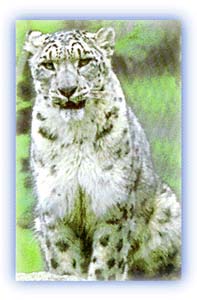Garhwal himalayas
General info
· Uttarakhand
· Eastern Garhwal
· Western Garhwal
Other Places of Interest
· Uttarkashi
People
· Jaunsaries
· Jadhs
· Marchas
· Bhotias
Religion
· Gods and Goddesses
Wildlife

![]()
The Garhwal region is full of high altitude alpine meadows where flowers of different hues bloom every spring. These are frequented by graziers and their flocks every summer. The Valley of Flowers is one such example and shepherds used to visit the valley in the summers for decades. However, after being declared a National Park, grazing has been disallowed. There are numerous beautiful alpine valleys which lie off the beaten track, with only the shepherds and the occasional trekking enthusiasts visiting them. |
 |
| Fleet-footed Bharal, the Himalayan Blue Sheep Credit: Karamjeet Singh |
Wildlife
The Garhwal region is rich in wildlife, and has always been so.
At the turn of the century, man-eating leopards used to be a
menace. This brought hunters like Jim Corbett to the area.
Stories of Jim Corbett and his exploits with the man eaters of
the region have since become famous. However, in today's
overpopulated world, wildlife is not visible as easily as
before. However, as people keep reminding you, it is there.
It is a common sight for trekkers to come across the Bharal -- the Himalayan blue sheep -- grazing in the alpine pastures. However, in spite of of its name, the Bharal is neither blue nor a sheep. It is a cross between a sheep and a goat, but is larger than either. Incredibly sure footed, Bharals usually graze over 14,000 ft, coming down lower only in the winters. They move around steep crumbly mountainsides, and move about in large herds. As a result, it is usually only the trekkers who get to see these animals. Higher up, and if one is lucky, one may even catch sight of the Ibex.
 |
| Musk Deer Credit: Mahabir Pun |
The area around Kedarnath is known for the elusive dog-like Moschus Moschiferus, or the Musk Deer. The Musk deer occupies a position somewhere between deer and antelope. Its distinguishing features include dog-like canines extending outside the mouth of the male. They are reclusive animals and generally hang out in solitary pairs, keeping to the dense undergrowth. Unfortunately, this elusiveness has not helped them survive in any considerable numbers. The species is hunted for the musk gland situated below the abdomen of the male.
Even more elusive are creatures like the leopards, the lynx and the mysterious snow leopard. Monkeys, however, are quite common, and they can be spotted swarming through the trees at many of the popular hill resorts.
 |
| Snow leopard - watchful eyes. Credit: Mahabir Pun |
Sometimes, high up in the skies, the largest bird in the Himalayas can be spotted -- the Lammergeier, basking in the heated rocks. The Lammergeier, or bearded vulture, has a wingspan of 9 ft from tip to tip. Its eagle-like appearance has meant that people often mistake it for a Golden Eagle. It ranges between four to twenty thousand feet. However, unlike an eagle, the Lammergeier is a scavenger.
All rights reserved
